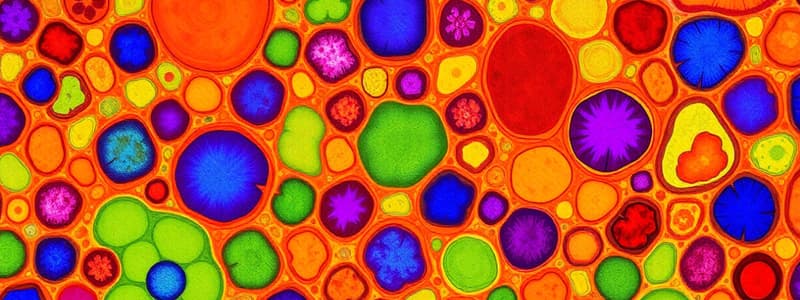Podcast
Questions and Answers
What type of epithelium is specialized for absorption and has microvilli?
What type of epithelium is specialized for absorption and has microvilli?
- Simple Squamous Epithelium
- Simple Columnar Epithelium (correct)
- Stratified Cuboidal Epithelium
- Pseudostratified Ciliated Columnar Epithelium
Which type of connective tissue provides energy storage and insulation?
Which type of connective tissue provides energy storage and insulation?
- Reticular Tissue
- Fibrous Connective Tissue
- Adipose Tissue (correct)
- Dense Connective Tissue
What is the primary function of endocrine glands?
What is the primary function of endocrine glands?
- To secrete substances onto body surfaces
- To produce hormones released into the bloodstream (correct)
- To provide structural support to tissues
- To produce enzymes for digestion
Transitional epithelium is capable of what key characteristic?
Transitional epithelium is capable of what key characteristic?
What type of connective tissue is primarily composed of adipocytes?
What type of connective tissue is primarily composed of adipocytes?
In which organ is reticular tissue primarily located?
In which organ is reticular tissue primarily located?
Stratified columnar epithelium is primarily found in which areas of the body?
Stratified columnar epithelium is primarily found in which areas of the body?
What are the three main types of connective tissue?
What are the three main types of connective tissue?
What are the four main types of tissues in the body?
What are the four main types of tissues in the body?
Which of the following correctly describes the role of connective tissue?
Which of the following correctly describes the role of connective tissue?
What distinguishes simple epithelium from stratified epithelium?
What distinguishes simple epithelium from stratified epithelium?
Which characteristic is true about keratinized stratified squamous epithelium?
Which characteristic is true about keratinized stratified squamous epithelium?
What are the three main shapes of epithelial cells?
What are the three main shapes of epithelial cells?
Where is simple squamous epithelium commonly found?
Where is simple squamous epithelium commonly found?
What is the function of epithelial tissue in the body?
What is the function of epithelial tissue in the body?
What is the function of the matrix in tissues?
What is the function of the matrix in tissues?
Flashcards are hidden until you start studying
Study Notes
Tissues
- Tissues are groups of cells working together for a specific function.
- Histology studies the structure and composition of tissues and organs at the microscopic level.
- There are four main types of tissues:
- Epithelial: covers the body surface and lines hollow organs.
- Connective: supports other tissues and binds them together.
- Muscle: allows the body to move.
- Nervous: made up of nerve cells that carry messages throughout the body.
Epithelial Tissue
- Functions: support, secretion, protection, and sensory reception.
- Shapes: squamous (flat), cuboidal (cube-like), columnar (column-like)
- Layers:
- Simple: single layer of cells.
- Stratified: multiple layers of cells stacked on top of each other.
- Types:
- Keratinized stratified squamous epithelium: protects the body from stress and forms the skin's epidermis.
- Non-keratinized stratified squamous epithelium: lacks keratin.
- Simple squamous epithelium (endothelium): lines blood vessels and the heart.
- Stratified squamous epithelium: found on the surface of the skin, tongue, and esophagus.
- Simple cuboidal epithelium: lines ducts and secretory glands of organs in the body.
- Stratified cuboidal epithelium: lining of some ducts, occurs in the excretory ducts of sweat glands and salivary glands.
- Simple columnar epithelium: lining of the stomach and intestine, specialized for absorption, has cilia and microvilli.
- Stratified columnar epithelium: small areas of the pharynx and mammary glands, provides protection and facilitates milk movement through ducts.
- Pseudostratified ciliated columnar epithelium: lines the nasal cavity, trachea, bronchi, and other parts of the respiratory tract.
- Transitional epithelium: stratified epithelium that can withstand stretching and recoiling.
- Appearance: changes based on stretching, can look plump and cuboidal when flat, found in the urinary bladder and ureter.
Glands
- Endocrine glands: release hormones into the bloodstream.
- Exocrine glands: secrete substances onto the body surface through ducts.
Connective Tissue
- Functions: support, protect, and give structure to other tissues and organs.
- Types:
- Fibrous: dense connective tissue (e.g., tendons, ligaments) and loose connective tissue (e.g., areolar, adipose, reticular).
- Fluid: blood and lymph.
- Supporting: cartilage and bone.
- Cell types and functions:
- Fibroblasts: secrete collagen proteins, maintain the structural framework of tissues.
- Macrophages: ingest and degrade dead cells, debris, tumor cells, and foreign materials.
- Adipocytes: provide energy storage, insulation, and cushioning around soft organs.
- Mesenchymal cells: support and maintain other cells.
- Melanocytes: produce and distribute melanin.
- Mast cells: protect the body from foreign invaders and toxins.
- Lymphocytes: part of the immune system, fight foreign invaders.
- Plasma cells: produce antibodies, play a critical role in the immune response.
- Adipose tissue: loose connective tissue composed of adipocytes, stores energy, insulates the body, and cushions internal organs.
- Loose connective tissue:
- Areolar tissue: supports organs and tissues, holds fluid.
- Adipose tissue: storage, insulation, cushioning.
- Reticular tissue: provides a supporting framework, located in the spleen, liver, and lymph nodes.
- Dense connective tissue: mostly made up of tough protein fibers (collagen).
Studying That Suits You
Use AI to generate personalized quizzes and flashcards to suit your learning preferences.




